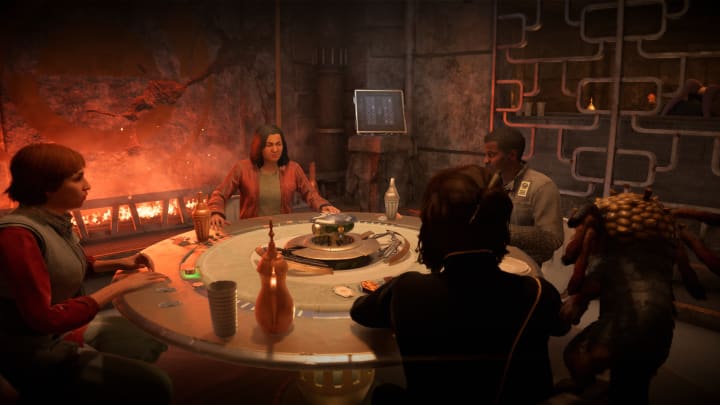Star Wars Outlaws Sabacc guide and how to win

Every great game has a card minigame nestled somewhere within it. Final Fantasy 8’s Triple Triad, Final Fantasy 7 Rebirth’s Queen’s Blood, The Witcher 3’s Gwent — if a game has a card minigame, it’s probably a good one. Star Wars Outlaws is no different, with a nifty little game called Sabacc.
Sabacc tables can be found all throughout the galaxy in Star Wars Outlaws, and not only are they a great way to earn money, they often have high-value rewards you can’t find anywhere else, like cosmetics. But Sabacc can be a tricky game, and it so often feels like you’re relying solely on luck. Fear not, though, because there is a surefire way to win (almost) any Sabacc game in Star Wars Outlaws.
In this guide we’ll go over the general rules of Sabacc, which are a bit confusing in-game, then go over our strategy to win any Sabacc game in the galaxy.
For more guides, check out our Star Wars Outlaws walkthrough with everything you need to know.
Star Wars Outlaws: Sabacc rules
Sabacc is a fairly simple game overall. Your primary goal is to have a hand of two cards, one sand-colored and one blood-colored, with the lowest value possible. Cards are numbered from 1 to 6, and your two cards are subtracted from each other at the end of each round and compared against the other players at the table. Say, for example, you have a 1 and a 3, while your opponent has a 2 and a 5. Your score would be 2, and your opponent’s score would be 3, so you’d win that round.
But getting a low value won’t win you the game. Instead, what you’re aiming for is a pair of the same card value, called a Sabacc. A Sabacc will always outrank a disparate duo, because the difference between them is 0. The lower the value of the pair, the more powerful the card is — a pair of 1s is one of the best hands in the game, while a pair of 6s, while still above a disparate hand, is pretty low in the rankings. There are also two joker-type cards: the Sylop, which has the same value as the other card in your hand, and the Imposter, which has you roll two dice and pick one to represent the value of the card. Two Sylop cards, called a Sylop Sabacc, is the best hand in the game.
Each turn, you can spend a chip to draw either a blood card or a sand card to add to your hand, and then you’ll need to discard a card — either the one you just picked up, or the one you had previously. There are four slots to draw from, two face-down decks, and two face-up discard piles. You can also choose to stand, opting not to spend any chips and instead holding onto the cards you have in your hand.
At the end of the round, all players reveal their hands, and chips are deducted. Any player with a disparate hand has to pay the difference in chips between their two card values, and players will lose the chips they spent drawing. The winner of the round gets to keep all of their wagered chips, while the losing player loses an extra chip, on top of whatever else they lost. Any player that runs out of chips is eliminated, and the next round begins.
As we said, pretty simple overall, but it’ll take some getting used to. There are also shift tokens, which have a number of effects like reclaiming chips from the draw pool or making other players forfeit chips, and you can cheat with the help of Nix. We’ll get into those shortly.
Star Wars Outlaws: How to win Sabacc
Winning Sabacc can rely on a lot of luck, but we’ve come up with a fairly solid strategy that should get through most matches. Our strategy is broken up into four parts, and requires some specific shift tokens, namely the Exhaustion token, which you can get for winning a high stakes Sabacc game at the Crimson Dawn table on Kijimi. We’d also suggest having two Refund shift tokens to round out your trio – or a Refund and an Immunity token, also earned in the Kijimi match – which will come in handy, as you’ll see.
Here’s our four-step plan to win Sabacc:
Conserve your chips
The most important part of Sabacc is conserving your chips. You’ll want to play it as safe as possible to begin with, so live by the rule of “good enough”. If you see the chance to get a Sabacc, go for it, but otherwise as long as your hand has a difference of 1 or less, you should avoid drawing cards or taking risks. If you find yourself getting targeted by other players’ shift tokens or you have two chips in the draw pile, play a [get two chips back] shift token to build up your pool near the end of the round.
Wait for a 1v1
If you played carefully and didn’t get enormously unlucky, you should be able to outlast at least two other players. You want to be in a situation where there’s just you and one other player to make this strategy work, but you can get by with two if you’re lucky.
Cheat to see their cards
When you’re down to the 1v1, play the round up until the last turn, as indicated by the three dots in the bottom left-hand corner of the screen. Ideally you’ll have a Sabacc in your hand at this point, but still play conservatively if not — you might be playing this 1v1 round a few times. On the last turn, you’ll want to use Nix to cheat, sending your little lizard-cat buddy to spy on their cards so you can see what hand your opponent has. As a 1v1, you only have to complete the QTE once, so there’s a much lower risk of your opponent noticing and getting kicked out.
Destroy their hand
If Nix comes back and tells you that your opponent has a worse hand than you, you’re free to keep playing, as it’s the final turn and you’re probably going to win. If they have a better hand than you, though, or if they have a card in their hand that would match with one of yours, it’s time to play your [discard hand one] shift token. This will force your opponent to discard their hand into the discard piles and draw new cards from the face-down decks. This serves two purposes — the first is that it makes the chances of your opponent winning very slim, since they will have essentially random cards without the chance to recover, and the second is that you get to pick from their discarded hand. This can help you get a better hand, just to safeguard against your opponent getting lucky and drawing a couple of 3s.
This strategy isn’t entirely bulletproof, and you may get very unlucky and get knocked out in the first round before you get a chance to recover. Still, we’ve found it to be very consistent, winning a variety of high-value games against some of the toughest opponents in the galaxy.
